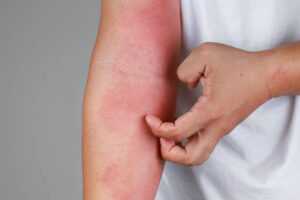[su_divider top=”no” style=”double” divider_color=”#952524″ link_color=”#952524″ size=”2″ margin=”10″]
What is Atopic Dermatitis? What are the symptoms of Atopic Dermatitis? How can homoeopathy help you? All of this is answered, in this post, and of course, our doctors are always there to help you. Just fill in your details in the form down below and we will answer all your questions for FREE!
[su_divider top=”no” style=”double” divider_color=”#952524″ link_color=”#952524″ size=”2″ margin=”10″]
[sc name=”query”]
Atopic dermatitis is a chronic relapsing inflammatory skin condition, also known as atopic eczema. It causes dryness, itchiness and inflammation of the skin and is localized to the flexural surfaces of the body. It usually occurs in childhood and it can continue flare-ups through adulthood. The symptoms can be managed with homoeopathic treatment and proper care.
What is atopic dermatitis?
It is an inflammation of the superficial skin it causes dry, itchy-inflamed skin. It is characterized by flare-ups of eczematous pruritic lesions over dry skin. There are several causes and it can be acute and chronic.
- In acute cases, epidermal oedema and intra-epidermal vesiculation are present predominately.
- In chronic cases, there is more epidermal thickening. It is associated with other atopic manifestations such as food allergy, allergic rhinitis, and asthma.
What are the causes of it?
The exact cause of atopic dermatitis is entirely unknown.
- Genetic factors are important.
- The skin surface is dry and cracked.
- The epidermis is made with a defect in filaggrin protein, so there is a defective skin barrier.
- Weak immunity.
- Family history of allergic rhinitis or asthma.
- Environmental factors like humidity or dampness, and poor hygiene.
How does it develop?
The subacute and chronic eczematous reaction caused by Type 1 (IgE-mediated) hypersensitivity reaction (release of histamine) produces prolonged severe pruritis. Our immune system triggers an inflammatory response that affects the skin. These causes develop many atopic dermatitis symptoms.
What are the triggering factors of atopic dermatitis?
The trigger factors for atopic dermatitis may vary from person to person. Some trigger factors worsen the symptoms that include:
- Strong soaps and detergents.
- Some fabrics, like wool and synthetic
- Skincare products, and cosmetics
- Some allergens (pollen, dander, dust)
- Physical irritants (dirt, sand, smoke)
- Anxiety and stress
- Cold, dry weather
- Heat and sweat
Foods that trigger atopic dermatitis:
Many foods can trigger atopic dermatitis. Some food allergens may include eggs, peanuts, tree nuts, soy, shellfish, wheat, cow’s milk and seafood.
Also Read: Food Triggers For Atopic dermatitis
How common is it?
Atopic dermatitis is quite common in children worldwide and it increasing the prevalence. It affects equally males and females. Most commonly it occurs in infants and children. It affects approximately 65% within the first year of life,15% to 20% of children and 1% to 3% of adults.
What does atopic dermatitis look like?
Atopic dermatitis tends to be red, weepy, crusty, itchy, and flaky patches, like oval or circular-shaped areas on the skin.
Also Read: Skin Care Tips For Atopic dermatitis
Is there any difference between eczema and atopic dermatitis?
The terms ‘eczema’ and ‘dermatitis’ are synonymous. Atopic dermatitis is also called atopic eczema.
What are the different phases of atopic dermatitis according to age?
It can occur anywhere in the body but most commonly affects the area where the skin flexes like behind the knees, inside the elbow, and in front of the neck. The distribution and character of rash may vary with age.
The distribution of atopic dermatitis according to age:
- Infants (onset at 2-6 months old) – Face, scalp, extensor surfaces
- Childhood (>18 months) – Flexural surfaces
- Adult – Hands, neck, flexures, feet, eyelids, forehead, face, wrists
What is the classification of atopic dermatitis?
Endogenous
- Atopic dermatitis
- Seborrhoeic dermatitis
Exogenous
- Irritant dermatitis
- Allergic dermatitis
- Photoallergic dermatitis
- Chronic actinic dermatitis
Characteristic patterns and morphology
- Asteatotic
- Discoid
- Gravitational
- Lichen simplex
- Pompholyx
What are the different types of atopic dermatitis?
All types of dermatitis cause itchiness and redness. But atopic contact dermatitis is the most common and severe type. The other types of atopic dermatitis may include:
Hand dermatitis – It affects the hand and is caused by frequent contact with irritating chemicals.
Dyshidrotic dermatitis – It is a type of eczema that develops on fingers, palms and the soles of the feet.
Neurodermatitis (lichenification) – The skin is thickened in patches due to repeated rubbing or scratching.
Nummular dermatitis – It is a chronic condition that causes coins-like spots that are often itchy.
Stasis dermatitis – It is a type of dermatitis that develops in people with poor circulation, basically in the lower legs.
Seborrheic dermatitis – This is an erythematous scaly rash affecting the scalp (dandruff), central face, eyebrows, central chest and upper back. It is associated with the overgrowth of pityrosporum yeasts.
What are the clinical features of atopic dermatitis?
The most common symptoms are:
- Itching
- Dry, scaly skin
- Swelling and inflammation
Other symptoms of atopic dermatitis:
- Red, purple or brown rashes
- Scaly patches at the site of the rash
- Lightened or darkened skin spots
- Thick, leathery skin
- Raw, sensitive skin from scratching
- Oozing and crusting
What are the associated findings with atopic dermatitis?
- Keratosis pilaris (hyperkeratosis of the hair follicle)
- Xerosis
- Atopic palms
- Inflammation, lichenification, and excoriations are secondary to persistent scratching.
Is atopic dermatitis contagious?
No, this condition is not contagious. It cannot be spread through casual touch.
Also Read: Atopic dermatitis in children
When should you see a doctor?
The signs of skin infection if you see such as:
- A red rash on the skin.
- Pain, Swelling, or heat around the rash.
- Discharge from the skin.
- Tenderness around the rash
What are the diagnostic criteria for atopic dermatitis?
There is no particular test to diagnose atopic dermatitis.
Pruritis and at least three of the following are required:
- History of itchy skin atopic dermatitis may include
- Dry skin (xeroderma)
- Visible flexural eczema
- Onset in the early age of life
- History of asthma, hay fever
Certain allergy tests (IgE) are to be performed to check the allergy levels in the blood.
- Atopy Patch test: It is used in the diagnosis of atopic dermatitis. A patch test to assess delayed hypersensitivity against those protein allergens known to obtain IgE-mediated type 1 reaction in atopic dermatitis.
- A skin biopsy may be required.
Also Read: Diagnosis and Assessment of Atopic dermatitis
What are the complications of atopic dermatitis?
Secondary infection:
- Bacterial infection: Staph. aureus
- Viral: Herpes simplex virus, papillomavirus, and molluscum contagiosum
Increased susceptibility to allergy:
- Food allergy: Eggs, cow’s milk, protein, shellfish, wheat, and soya.
- Increased risk of susceptibility to type IV allergens because of impaired barrier function.
Impact on life and health:
- Poor sleep, behavioural difficulties
- Impact on work, hobbies, sleep, psychology and quality of life in adults.
Also Read: Ways you are making your Eczema worse
How to manage atopic dermatitis?
To help reduce the itching and soothe inflamed skin.
Some self-care tips:
- Take a bath in cold water
- Moisturise skin at least twice a day. Do moisturise the skin immediately after the bath to prevent skin dryness.
- Use mild soap and moisturiser
- Apply an anti-itch ointment
- Avoid scratching and rubbing
- Wear cotton and comfortable clothing
- Use humidifier
- Increase water intake
- Treat stress and anxiety
- Avoid exposure to dust, smoke, pollen etc.
Dietary management:
- Anti-inflammatory diet help in reducing the symptom of dermatitis.
- Avoid dairy products.
- Foods are rich in omega-3 fatty acids.
- Foods are rich in potassium like bananas, sweet potatoes, avocado etc which help in reducing inflammation.
- Limit alcohol and spicy food.
- Take a fibre-rich diet.
Also Read: Lifestyle changes for Atopic Dermatitis
Can atopic dermatitis disappear on its own?
No, it can’t. Atopic dermatitis needs treatment and proper care. It affects not only the skin of the person but also his self-esteem and confidence. Atopic dermatitis affects their social interaction as well. So, don’t delay or ignore the treatment. Treat it with safe and natural homoeopathic medicines.
Also Read: Foods to eat in Atopic Dermatitis
Can homoeopathic treatment help in atopic dermatitis?
Yes, homoeopathic medicines can help symptomatically in this case. The medicine first helps in reducing the itching and severity of the disease. Homoeopathy has a good scope in treating cases of atopic dermatitis. Homoeopathic medicines are safe and don’t have any side effects.
Some homoeopathic medicines are:
- Graphites
- Psorinum
- Petroleum
- Sulphur
- Mezereum
Also Read: Homeopathic Management for atopic dermatitis
For more information, you can visit Healthline and Mayoclinic
Atopic Dermatitis- Detailed Description
[su_divider divider_color=”#952524″ link_color=”#952524″ size=”2″ margin=”10″]
[sc name=”know-your-doctor”]
[sc name=”more-links-diseases”]


